2013 VOLKSWAGEN GOLF GTI climate control
[x] Cancel search: climate controlPage 102 of 319
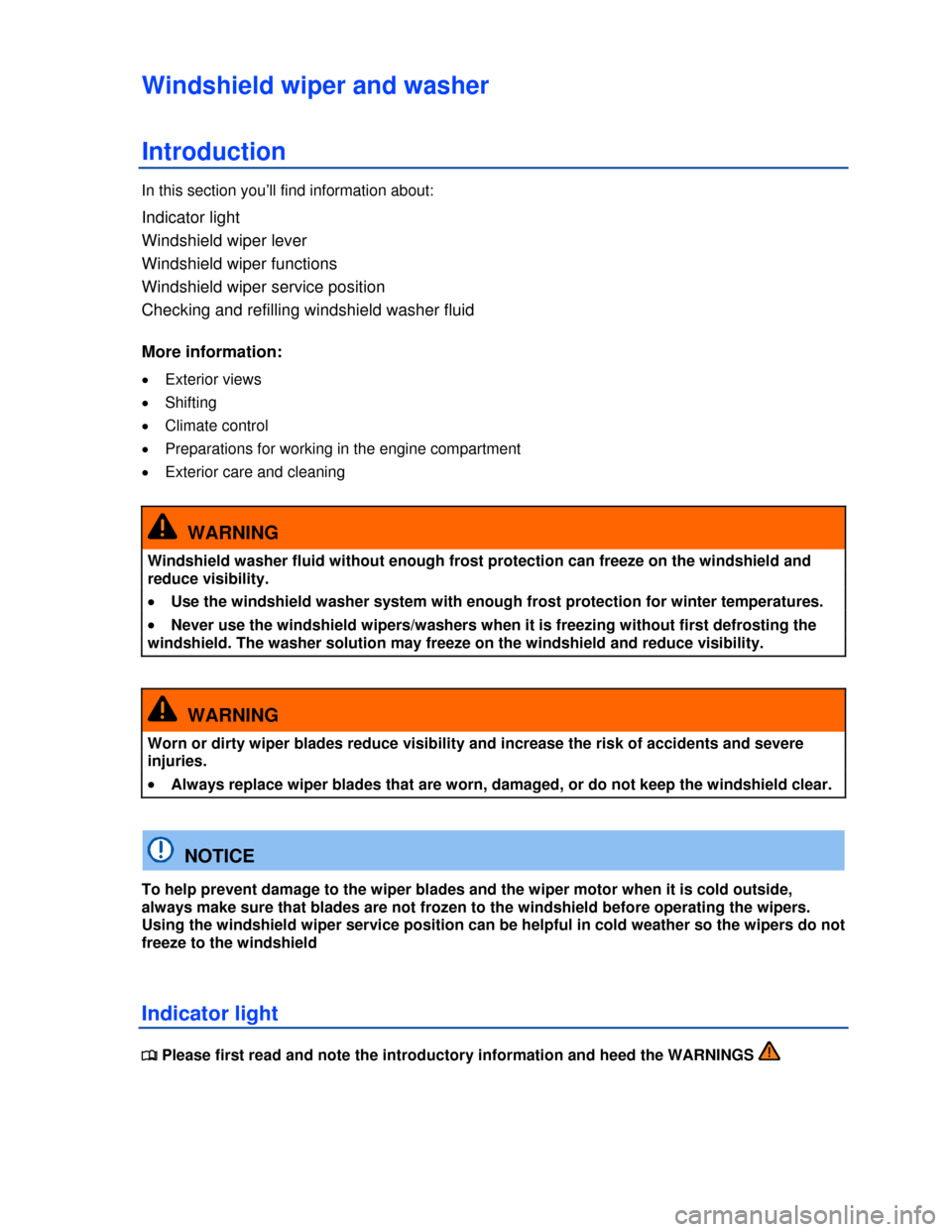
Windshield wiper and washer
Introduction
In this section you’ll find information about:
Indicator light
Windshield wiper lever
Windshield wiper functions
Windshield wiper service position
Checking and refilling windshield washer fluid
More information:
�x Exterior views
�x Shifting
�x Climate control
�x Preparations for working in the engine compartment
�x Exterior care and cleaning
WARNING
Windshield washer fluid without enough frost protection can freeze on the windshield and
reduce visibility.
�x Use the windshield washer system with enough frost protection for winter temperatures.
�x Never use the windshield wipers/washers when it is freezing without first defrosting the
windshield. The washer solution may freeze on the windshield and reduce visibility.
WARNING
Worn or dirty wiper blades reduce visibility and increase the risk of accidents and severe
injuries.
�x Always replace wiper blades that are worn, damaged, or do not keep the windshield clear.
NOTICE
To help prevent damage to the wiper blades and the wiper motor when it is cold outside,
always make sure that blades are not frozen to the windshield before operating the wipers.
Using the windshield wiper service position can be helpful in cold weather so the wipers do not
freeze to the windshield
Indicator light
�
Page 121 of 319
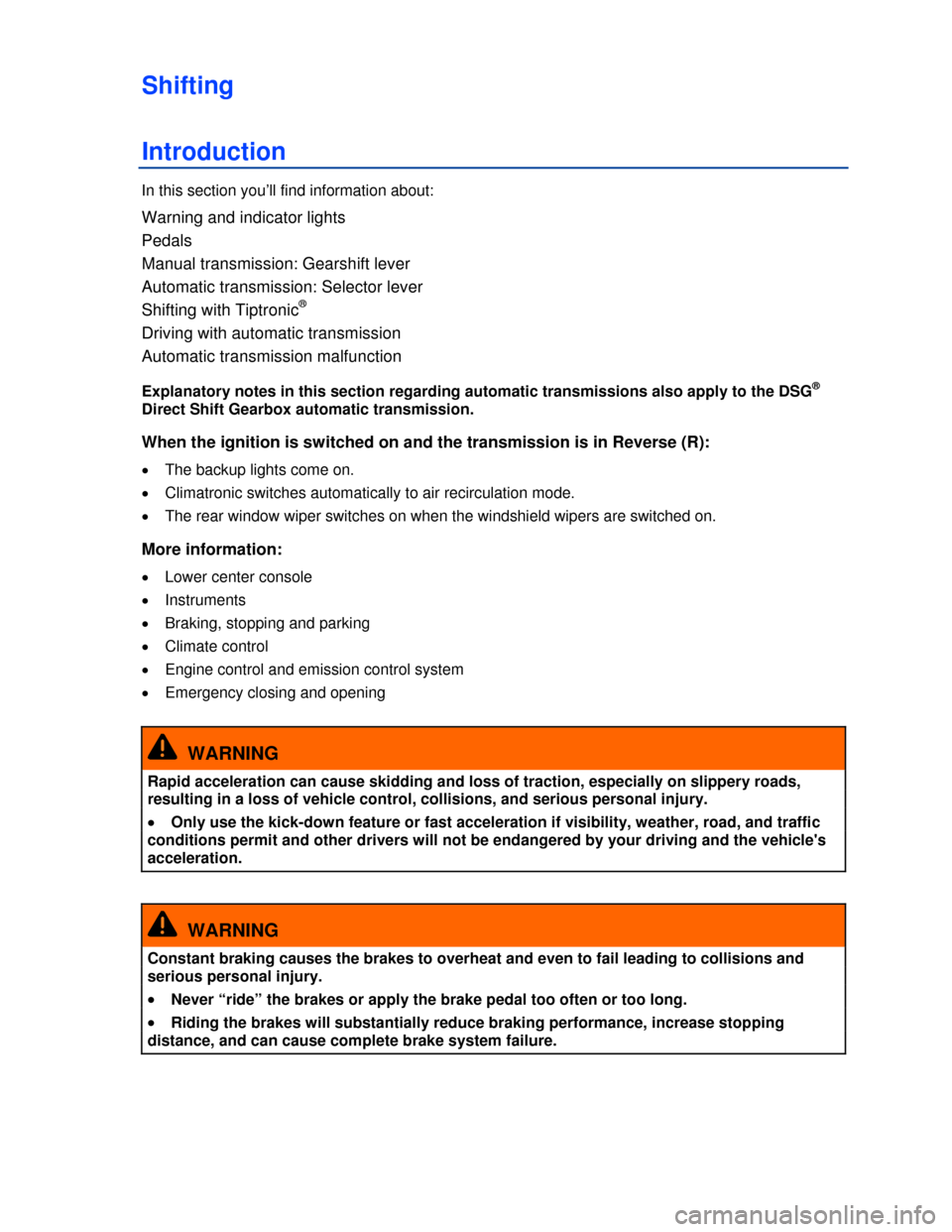
Shifting
Introduction
In this section you’ll find information about:
Warning and indicator lights
Pedals
Manual transmission: Gearshift lever
Automatic transmission: Selector lever
Shifting with Tiptronic®
Driving with automatic transmission
Automatic transmission malfunction
Explanatory notes in this section regarding automatic transmissions also apply to the DSG®
Direct Shift Gearbox automatic transmission.
When the ignition is switched on and the transmission is in Reverse (R):
�x The backup lights come on.
�x Climatronic switches automatically to air recirculation mode.
�x The rear window wiper switches on when the windshield wipers are switched on.
More information:
�x Lower center console
�x Instruments
�x Braking, stopping and parking
�x Climate control
�x Engine control and emission control system
�x Emergency closing and opening
WARNING
Rapid acceleration can cause skidding and loss of traction, especially on slippery roads,
resulting in a loss of vehicle control, collisions, and serious personal injury.
�x Only use the kick-down feature or fast acceleration if visibility, weather, road, and traffic
conditions permit and other drivers will not be endangered by your driving and the vehicle's
acceleration.
WARNING
Constant braking causes the brakes to overheat and even to fail leading to collisions and
serious personal injury.
�x Never “ride” the brakes or apply the brake pedal too often or too long.
�x Riding the brakes will substantially reduce braking performance, increase stopping
distance, and can cause complete brake system failure.
Page 138 of 319
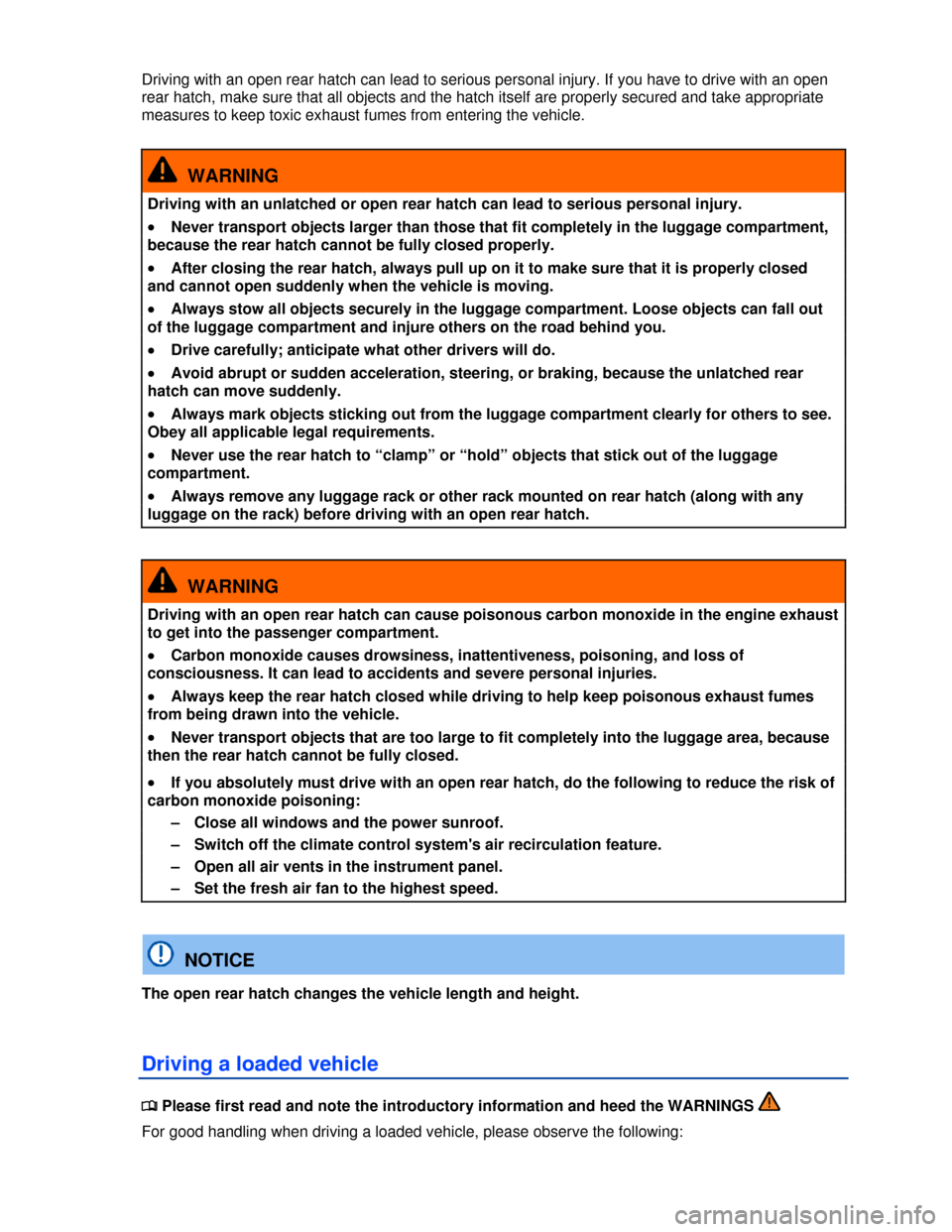
Driving with an open rear hatch can lead to serious personal injury. If you have to drive with an open
rear hatch, make sure that all objects and the hatch itself are properly secured and take appropriate
measures to keep toxic exhaust fumes from entering the vehicle.
WARNING
Driving with an unlatched or open rear hatch can lead to serious personal injury.
�x Never transport objects larger than those that fit completely in the luggage compartment,
because the rear hatch cannot be fully closed properly.
�x After closing the rear hatch, always pull up on it to make sure that it is properly closed
and cannot open suddenly when the vehicle is moving.
�x Always stow all objects securely in the luggage compartment. Loose objects can fall out
of the luggage compartment and injure others on the road behind you.
�x Drive carefully; anticipate what other drivers will do.
�x Avoid abrupt or sudden acceleration, steering, or braking, because the unlatched rear
hatch can move suddenly.
�x Always mark objects sticking out from the luggage compartment clearly for others to see.
Obey all applicable legal requirements.
�x Never use the rear hatch to “clamp” or “hold” objects that stick out of the luggage
compartment.
�x Always remove any luggage rack or other rack mounted on rear hatch (along with any
luggage on the rack) before driving with an open rear hatch.
WARNING
Driving with an open rear hatch can cause poisonous carbon monoxide in the engine exhaust
to get into the passenger compartment.
�x Carbon monoxide causes drowsiness, inattentiveness, poisoning, and loss of
consciousness. It can lead to accidents and severe personal injuries.
�x Always keep the rear hatch closed while driving to help keep poisonous exhaust fumes
from being drawn into the vehicle.
�x Never transport objects that are too large to fit completely into the luggage area, because
then the rear hatch cannot be fully closed.
�x If you absolutely must drive with an open rear hatch, do the following to reduce the risk of
carbon monoxide poisoning:
– Close all windows and the power sunroof.
– Switch off the climate control system's air recirculation feature.
– Open all air vents in the instrument panel.
– Set the fresh air fan to the highest speed.
NOTICE
The open rear hatch changes the vehicle length and height.
Driving a loaded vehicle
�
Page 188 of 319
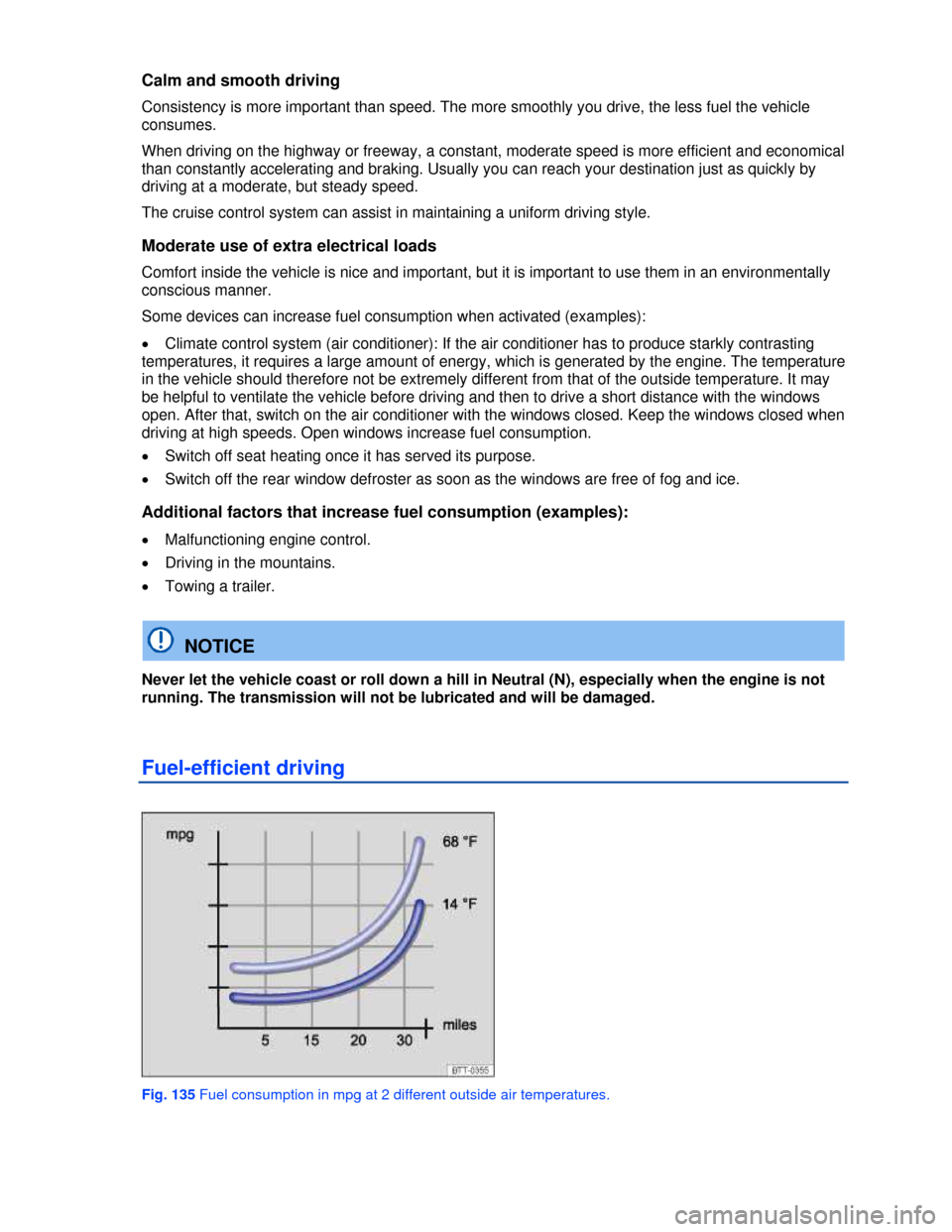
Calm and smooth driving
Consistency is more important than speed. The more smoothly you drive, the less fuel the vehicle
consumes.
When driving on the highway or freeway, a constant, moderate speed is more efficient and economical
than constantly accelerating and braking. Usually you can reach your destination just as quickly by
driving at a moderate, but steady speed.
The cruise control system can assist in maintaining a uniform driving style.
Moderate use of extra electrical loads
Comfort inside the vehicle is nice and important, but it is important to use them in an environmentally
conscious manner.
Some devices can increase fuel consumption when activated (examples):
�x Climate control system (air conditioner): If the air conditioner has to produce starkly contrasting
temperatures, it requires a large amount of energy, which is generated by the engine. The temperature
in the vehicle should therefore not be extremely different from that of the outside temperature. It may
be helpful to ventilate the vehicle before driving and then to drive a short distance with the windows
open. After that, switch on the air conditioner with the windows closed. Keep the windows closed when
driving at high speeds. Open windows increase fuel consumption.
�x Switch off seat heating once it has served its purpose.
�x Switch off the rear window defroster as soon as the windows are free of fog and ice.
Additional factors that increase fuel consumption (examples):
�x Malfunctioning engine control.
�x Driving in the mountains.
�x Towing a trailer.
NOTICE
Never let the vehicle coast or roll down a hill in Neutral (N), especially when the engine is not
running. The transmission will not be lubricated and will be damaged.
Fuel-efficient driving
Fig. 135 Fuel consumption in mpg at 2 different outside air temperatures.
Page 205 of 319

Applicable only in the United States
Heating and air conditioning
Introduction
In this section you’ll find information about:
Controls
Controls
Air conditioner operation
Air vents
Air recirculation
Air recirculation
Manual air conditioning (AC) and Climatronic
Your vehicle is equipped either with a Manual AC climate control system or a Climatronic
climate control system.
On vehicles with Climatronic climate control, Climatronic information appears in the Climatronic display
and/or on the screen of the factory-installed Radio system or Radio & Navigation system.
The temperature units (Fahrenheit or Celsius) in the factory-installed Radio system or Radio &
Navigation system screen can be changed in the Settings menu in the Premium instrument cluster
display in appropriately equipped vehicles.
The dust and pollen filter
The dust and pollen filter with an activated carbon insert reduces the entry of pollutants into the
passenger compartment.
The dust and pollen filter must be replaced at the intervals recommended in ⇒ Booklet Warranty and
Maintenance so that the air conditioner can work properly.
If the effectiveness of the filter decreases prematurely due to operating the vehicle where the outside
air is heavily polluted, the dust and pollen filter should be replaced more frequently than indicated.
More information:
�x Exterior views
�x Passenger compartment
�x Volkswagen Information System
�x Seat functions
�x Windshield wiper and washer
�x Starting and stopping the engine
�x Exterior care and cleaning
Page 206 of 319
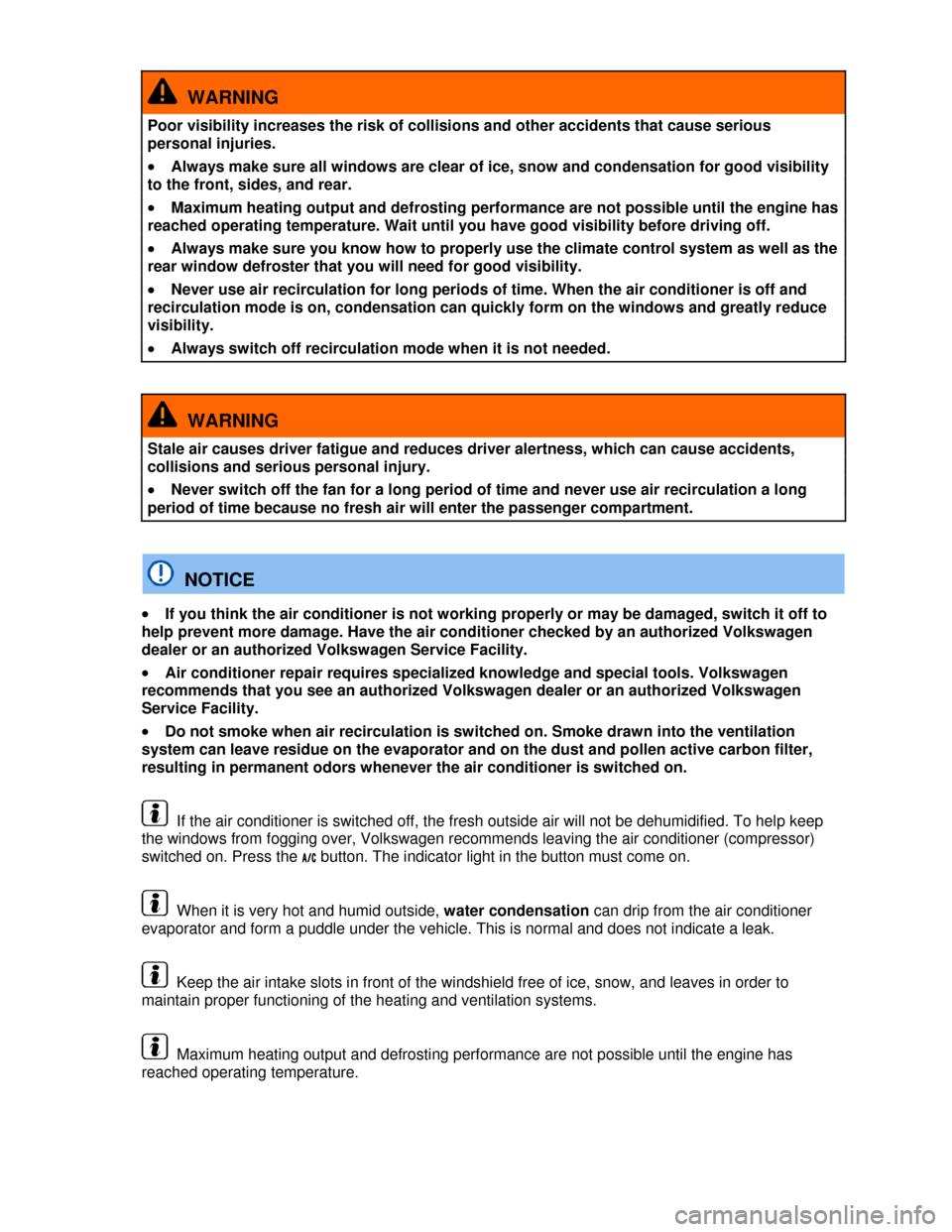
WARNING
Poor visibility increases the risk of collisions and other accidents that cause serious
personal injuries.
�x Always make sure all windows are clear of ice, snow and condensation for good visibility
to the front, sides, and rear.
�x Maximum heating output and defrosting performance are not possible until the engine has
reached operating temperature. Wait until you have good visibility before driving off.
�x Always make sure you know how to properly use the climate control system as well as the
rear window defroster that you will need for good visibility.
�x Never use air recirculation for long periods of time. When the air conditioner is off and
recirculation mode is on, condensation can quickly form on the windows and greatly reduce
visibility.
�x Always switch off recirculation mode when it is not needed.
WARNING
Stale air causes driver fatigue and reduces driver alertness, which can cause accidents,
collisions and serious personal injury.
�x Never switch off the fan for a long period of time and never use air recirculation a long
period of time because no fresh air will enter the passenger compartment.
NOTICE
�x If you think the air conditioner is not working properly or may be damaged, switch it off to
help prevent more damage. Have the air conditioner checked by an authorized Volkswagen
dealer or an authorized Volkswagen Service Facility.
�x Air conditioner repair requires specialized knowledge and special tools. Volkswagen
recommends that you see an authorized Volkswagen dealer or an authorized Volkswagen
Service Facility.
�x Do not smoke when air recirculation is switched on. Smoke drawn into the ventilation
system can leave residue on the evaporator and on the dust and pollen active carbon filter,
resulting in permanent odors whenever the air conditioner is switched on.
If the air conditioner is switched off, the fresh outside air will not be dehumidified. To help keep
the windows from fogging over, Volkswagen recommends leaving the air conditioner (compressor)
switched on. Press the �!�
Page 212 of 319
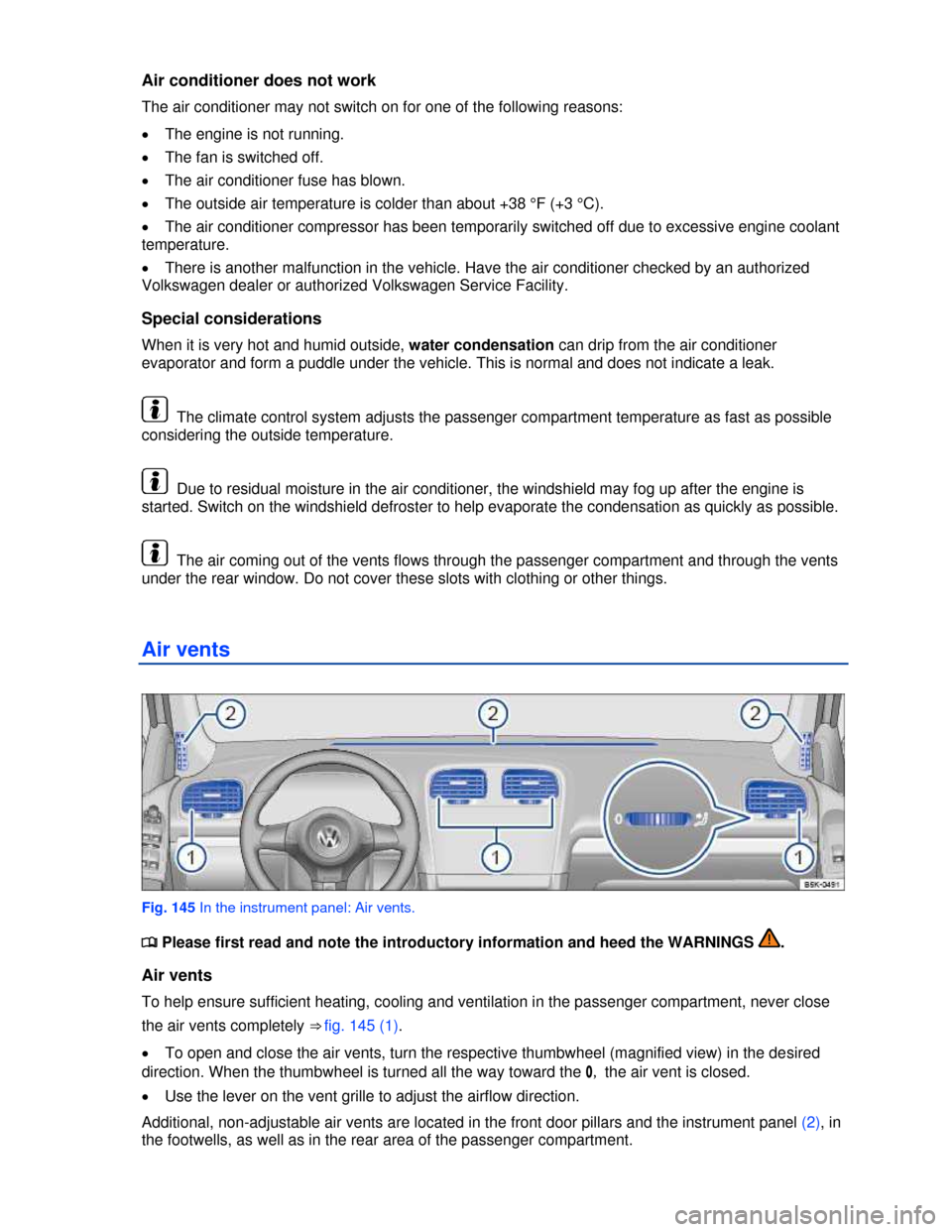
Air conditioner does not work
The air conditioner may not switch on for one of the following reasons:
�x The engine is not running.
�x The fan is switched off.
�x The air conditioner fuse has blown.
�x The outside air temperature is colder than about +38 °F (+3 °C).
�x The air conditioner compressor has been temporarily switched off due to excessive engine coolant
temperature.
�x There is another malfunction in the vehicle. Have the air conditioner checked by an authorized
Volkswagen dealer or authorized Volkswagen Service Facility.
Special considerations
When it is very hot and humid outside, water condensation can drip from the air conditioner
evaporator and form a puddle under the vehicle. This is normal and does not indicate a leak.
The climate control system adjusts the passenger compartment temperature as fast as possible
considering the outside temperature.
Due to residual moisture in the air conditioner, the windshield may fog up after the engine is
started. Switch on the windshield defroster to help evaporate the condensation as quickly as possible.
The air coming out of the vents flows through the passenger compartment and through the vents
under the rear window. Do not cover these slots with clothing or other things.
Air vents
Fig. 145 In the instrument panel: Air vents.
�